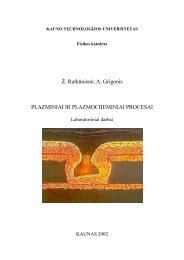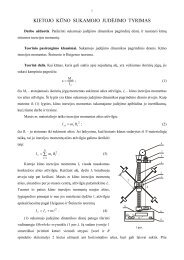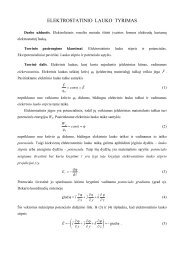PROCEEDINGS OF THE 7 INTERNATIONAL ... - Fizika
PROCEEDINGS OF THE 7 INTERNATIONAL ... - Fizika
PROCEEDINGS OF THE 7 INTERNATIONAL ... - Fizika
You also want an ePaper? Increase the reach of your titles
YUMPU automatically turns print PDFs into web optimized ePapers that Google loves.
I. Gajauskaite et al. / Medical Physics in the Baltic States 7 (2009) 100 – 101<br />
3. Tritium sources in nuclear sector<br />
At present, it is considered, that the main source of<br />
manmade tritium is a nuclear fuel cycle (nuclear power<br />
stations and nuclear fuel reprocessing plants).<br />
The new sources of tritium are tritium production plants<br />
for nuclear fusion technology and tritium release during<br />
fusion experiments. Tritium release from nuclear power<br />
plant depends on the reactor type. The nuclear power<br />
stations using light water reactors (PWR - pressurized<br />
water reactor and BWR – boiling water reactor) have<br />
rather low discharge of tritium as compared to others<br />
types of reactors used in European Union (GCR- gas<br />
cooled reactor and AGR- advanced gas cooled reactor).<br />
Annual normalized discharge of airborne tritium<br />
activities from different reactor types used in EU [5] are<br />
presented in Figure 1 and of the liquid tritium – in<br />
Figure 2.<br />
Normalized activities, GBq/GWh<br />
100<br />
10<br />
1<br />
0.1<br />
PWR BWR GCR AGR<br />
Fig1. Normalized annual releases (GBq/GWh) by<br />
reactor type for airborne tritium<br />
Normalized activities,<br />
GBq/GWh<br />
100<br />
10<br />
1<br />
0.1<br />
PWR BWR GCR AGR<br />
Fig2. Normalized annual discharges by reactor type for<br />
liquid tritium<br />
In heavy water reactors annual airborne tritium releases<br />
ranges from 0,1 PBq to 1 PBq and liquid tritium<br />
releases from 0,1 PBq to 0,5 PBq [1]. Most significant<br />
contribution is due to reprocessing plants.<br />
4. Determination of tritium activity in Ignalina NPP<br />
Article 35 of the Euratom Treaty requires that each<br />
Member State shall establish nuclear facilities necessary<br />
to carry out continuous monitoring of the levels of<br />
radioactivity in air, water and soil and to ensure<br />
compliance with the basic safety standards.<br />
The World Health Organization set the annual effective<br />
dose limit of 0,1 mSv for daily consumption of triated<br />
101<br />
water. Besides that, in keeping with the philosophy of<br />
ALARA, internal exposure should be kept as low as<br />
practical. In that connection, tritium is one of several<br />
radioactive nuclides routinely monitored in and around<br />
nuclear power plants.<br />
Measurements of the released to the atmosphere tritium<br />
in Ignalina nuclear power plant are performed using<br />
combined T- 14 C unit, produced by ATOMKI (the<br />
accredited Institute of Nuclear Research of the<br />
Hungarian Academy of Sciences) [6]. Unit consists of<br />
absorption vapor samplers, based on the fact that vapor<br />
can be bound and collected with the hygroscopic agent.<br />
The bound water can be recovered in the laboratory and<br />
the tritium concentration of the water can be measured.<br />
The activity of tritium is measured by liquid scintillation<br />
method. The limit of measurement is 7 mBk/m 3 .<br />
Specific activity of tritium releases to the cooling water<br />
channel from RBMK reactor for 2008 is shown in the<br />
Fig.3.<br />
Specific activity, Bq/l<br />
20<br />
15<br />
10<br />
5<br />
0<br />
I II III IV VI VII X XI XII<br />
Fig. 3 Specific activity of liquid tritium releases from<br />
RBMK reactor during 2008.<br />
5. References<br />
1. C.Boyer, L.Vichot et all. Tritium in plants: A review<br />
of current knowledge. Environmental and<br />
Experimental Botany 67 (2009) 34-51<br />
2. C.Varlam, I.Stefanescui et all., Applying direct liquid<br />
scintillation counting to low level tritium<br />
measurement. Applied Radiation and Isotopes 67<br />
(2009) 812-816<br />
3. M.Villa, G. Manjon. Low-level measurements of<br />
tritium in water. Applied Radiation and Isotopes 61<br />
(2004) 319-323.<br />
4. L. Vichot, C. Boyer et all. Organically bound tritium<br />
(OBT) for various plants in the vicinity of a<br />
continuous atmospheric tritium release. Journal of<br />
Environmental Radioactivity 99 (2008) 1636-1643.<br />
5. S. Van der Stricht., A, Jensens. Radioactive effluents<br />
from nuclear power stations and nuclear fuel<br />
reprocessing plants in the European Union, 1995-<br />
1999. Radiation protection 127, European<br />
Commission Directorate-General Environment. 2001.<br />
6. G. Vodila, M.Molnar et all., Mapping of tritium<br />
emissions using absorption vapor samplers. Journal of<br />
Environmental Radioactivity 100 (2009) 120-124








